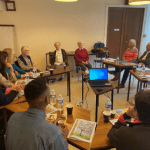A History of the Congregation of Our Lady

Late 16th Century
The universe is expanding, our view of the world is changing, and the human race now has a different view of itself
The Council of Trent has just been concluded. An important new movement of spiritual renewal is sweeping through the Church. This is the “century of saints”: Ignatius of Loyola, Thérèse of Avila, John of the Cross, Vincent de Paul, Bérulle, Francis de Sales…
The end of the 16th century was a difficult time for the Duchy of Lorraine, at that time independent of France, with corruption of morals, social injustice, extreme poverty, endless wars, famine, epidemics, wars of religion, ignorance and moral deprivation among clergy and religious, abandonment of people…
In 1597, at Christmas Midnight Mass celebrated by Peter Fourier in the church at Mattaincourt, Alix, then aged 21, consecrated her life to God, together with four companions. Thus was born the Congregation.
At the end of the 16th century education for girls was practically inexistent. Conscious of this urgent need, Peter Fourier and Alix Le Clerc decided to offer free education to young girls from rich and poor families. A revolutionary idea at that time!
Their objective: a real promotion of women, in order to transform society.
1598: the first free school for girls opened in Poussay. At the same time, Peter Fourier was writing a Constitution for the new Congregation. In 1616 he obtained approval from Rome. In 1628 the Sisters of the Congregation of Our Lady adopted the name of Canonesses of St Augustine, to obtain recognition of their apostolic life.
Less than a century later
They have 80 houses, in Lorraine, throughout France and in several neighbouring countries! Attached to each school was a monastery. The Sisters came there to live in community, following the strict rules which then governed all women’s convents.
Each monastery was autonomous, but they all lived in one great union, supporting each other in need, offering true mutual aid.
The turmoil of history
Despite many trials: war, persecution, repeated dispersal… the Sisters sought refude in other countries where they could pursue their mission in education.
Early 20th century
Some monasteries moved into federations, others created Unions. In 1963, the houses of the two large Unions became one, today’s Congregation of Our Lady.
Post-Vatican II
In response to the Council’s call to greater openness to the world, the Congregation sought new answers, relevant to their localities and to the needs of the people around them. Smaller communities began to grow everywhere, and religious life took on a new form.
The present
Remaining true to the ideas which originally inspired them, the Sisters of the Congregation of Our Lady seek to respond to the needs of their times.
Their care is given primarily to the poor, the oppressed, the neglected. Everywhere they go, the Sisters work for the development and growth of the individual, through education and training, on all levels, and according to the country. How do they achieve this?
– by providing a general education
– instruction in the faith
– education about justice
– and engaging with the poor.
Sent by the Congregation, they live in small groups in “fraternity”:
– sharing life on a daily basis
– with an individual and a group mission
– with prayer in private and in community.
The unity of the Sisters, reflection and choice of projects is determined:
– in each country, by a team of Sisters elected to this role,
– at international level, by a group elected by the General Chapter, for 6 years’ service to the entire Congregation.
All Sisters are responsible for the unity of the Congregation and the paths it follows, be that within their daily fraternal communities, on a national or international scale. As far as possible, all Sisters participate together in the decision-making process.


















